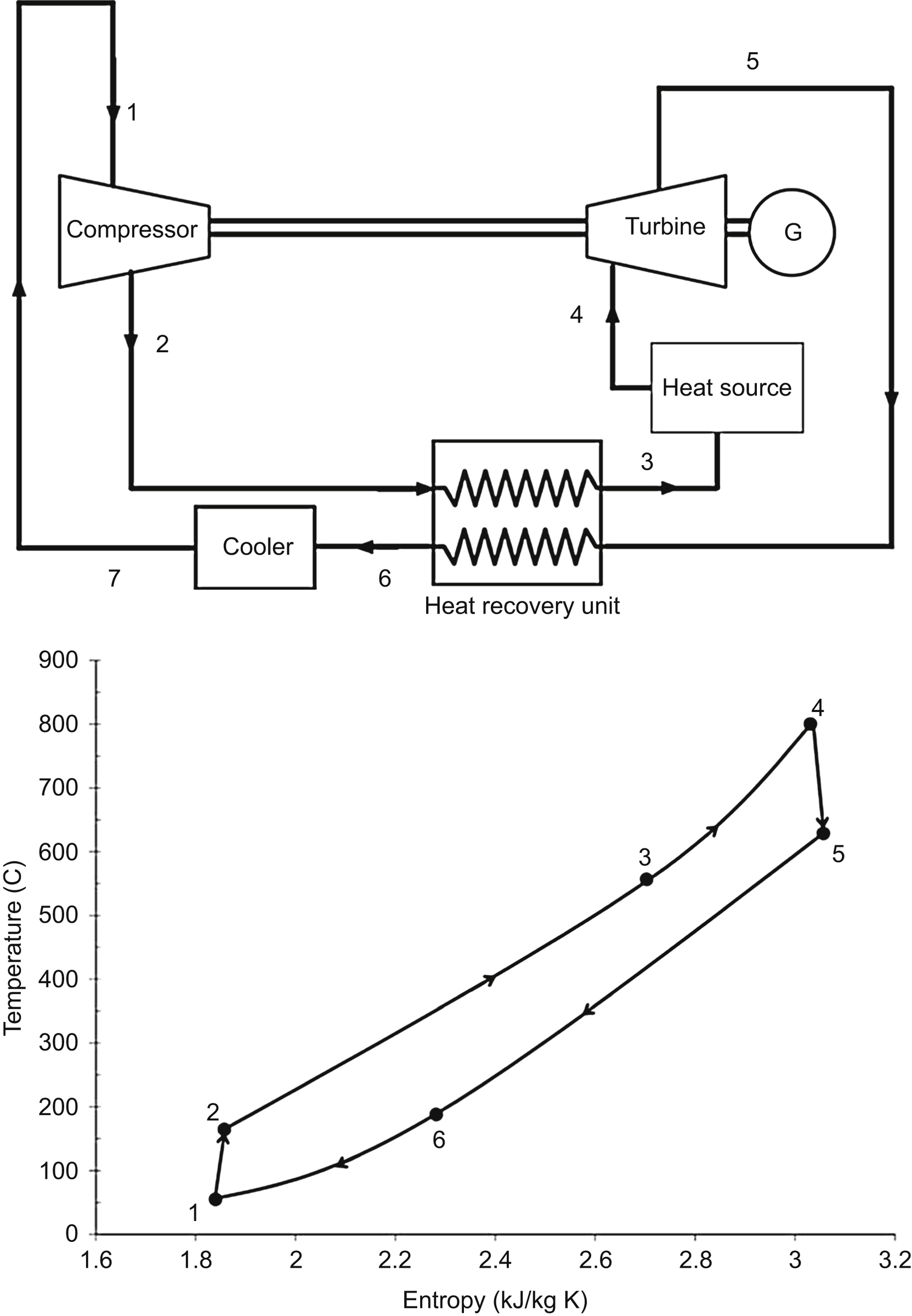[1] Besarati S.M, Yogi Goswami D. Analysis of advanced supercritical carbon dioxide power cycles with a bottoming cycle for concentrating solar power applications. Journal of Solar Energy Engineering. 2014;136(1):011020.
[2] Cheang V.T, Hedderwick R.A, McGregor C. Benchmarking supercritical carbon dioxide cycles against steam Rankine cycles for concentrated solar power. Solar Energy. 2015;113:199–211.
[3] Chen H, Goswami D.Y, Rahman M.M, Stefanakos E.K. A supercritical Rankine cycle using zeotropic mixture working fluids for the conversion of low-grade heat into power. Energy. 2011;88(8):549–555.
[4] Chen H, Goswami D.Y, Stefanakos E.K. A review of thermodynamic cycles and working fluids for the conversion of low-grade heat. Renewable and Sustainable Energy Reviews. 2010;14(9):3059–3067.
[5] Demirkaya G, Besarati S.M, Padilla R.V, Archibold A.R, Goswami D.Y, Rahman M.M, Stefanakos E.K. Multi-objective optimization of a combined power and cooling cycle for low-grade and mid-grade heat sources. Journal of Energy Resources Technology. 2012;134(3):032002.
[6] Dostal V. A supercritical carbon dioxide cycle for next generation nuclear reactors. Massachusetts Institute of Technology (MIT); 2004.
[7] Dostal V, Hejzlar O, Driscoll M.J. The supercritical carbon dioxide power cycle: comparison to other advanced cycles. Nuclear Technology. 2006;154(3):283–301.
[8] DTI. Advanced power plant using high efficiency boiler/turbine. 2006 Available at: http://cartechcapstone.wikispaces.com/file/view/BPB010(1).pdf.
[9] Dunham M.T, Iverson B.D. High-efficiency thermodynamic power cycles for concentrated solar power systems. Renewable and Sustainable Energy Reviews. 2014;30:758–770.
[10] El-Sayed Y.M, Tribus M. A theoretical comparison of the Rankine and Kalina cycles. In: Analysis of energy systems, design and operation, annual meeting of the American Society of Mechanical Engineers. Miami, Florida. 1985.
[11] Goswami D.Y. Solar thermal power technology: present status and ideas for the future. Energy Sources. 1998;20(2):137–145.
[12] Jonsson M, Yan J. Ammonia–water bottoming cycles: a comparison between gas engines and gas diesel engines as prime movers. Energy. 2001;26(1):31–44.
[13] Kalina A. Combined-cycle system with novel bottoming cycle. Journal of Engineering for Gas Turbines and Power. 1984;106(4):737–742.
[14] Kolb G.J, Ho C.K, Mancini T.R, Gary J.A. Power tower technology roadmap and cost reduction plan. 2011 [Albuquerque, NM].
[15] Kribus A, Zaibel R, Carey D, Segal A, Karni J. A solar-driven combined cycle power plant. Solar Energy. 1998;62(2):121–129. .
[16] Lemmon E.W, Mclinden M.O, Huber M.L. NIST reference fluid thermodynamic and transport properties — REFPROP. NIST; 2013 Standard reference database 23.
[17] Li C, Besarati S, Goswami Y, Stefanakos E, Chen H. Reverse osmosis desalination driven by low temperature supercritical organic rankine cycle. Applied Energy. 2013;102:1071–1080.
[18] Ma Z, Turchi C.S. Advanced supercritical carbon dioxide power cycle configurations for use in concentrating solar power systems preprint. In: Supercritical CO2 for Application in Concentrating Solar Power Systems, Proceedings of SCCO2 Power Cycle Symposium 2009. 2011.
[19] Marston C.H, Hyre M. Gas turbine bottoming cycles: triple-pressure steam versus Kalina. Journal of Engineering for Gas Turbines and Power. 1995;117(1):10–15.
[20] Mittelman G, Epstein M. A novel power block for CSP systems. Solar Energy. 2010;84(10):1761–1771.
[21] Neises T, Turchi C. A comparison of supercritical carbon dioxide power cycle configurations with an emphasis on CSP applications. Energy Procedia. 2013;49:1187–1196.
[22] Padilla R.V, Too Y.C.S, Benito R, Stein W. Exergetic analysis of supercritical CO2 Brayton cycles integrated with solar central receivers. Applied Energy. 2015;148:348–365.
[23] Padilla R.V, Archibold A.R, Demirkaya G, Besarati S, Goswami D.Y, Rahman M.M, Stefanakos E.K. Performance analysis of a rankine cycle integrated with the Goswami combined power and cooling cycle. Journal of Energy Resources Technology. 2012;134(3):032001.
[24] Peng S, Hong H, Jin H, Wang Z. An integrated solar thermal power system using intercooled gas turbine and Kalina cycle. Energy. 2012;44(1):732–740.
[25] Price H. Assessment of parabolic trough and power tower solar technology cost and performance forecasts. 2003 [Golden, CO].
[26] Price H.W, Whitney D.D, Beebe H.I. SMUD Kokhala power tower study. In: American Society of Mechanical Engineers - international solar energy conference, San Antonio, TX. 1996.
[27] Saleh B, Koglbauer G, Wendland M, Fischer J. Working fluids for low-temperature organic Rankine cycles. Energy. 2007;32:1210–1221.
[28] Schwarzbözl P, Buck R, Sugarmen C, Ring A, Crespo M.J.M, Altwegg P, Enrile J. Solar gas turbine systems: design, cost and perspectives. Solar Energy. 2006;80(10):1231–1240.
[29] Tchanche B.F, Papadakis G, Lambrinos G, Frangoudakis A. Fluid selection for a low-temperature solar organic Rankine cycle. Applied Thermal Engineering. 2009;29(11–12):2468–2476.
[30] Tsiklauri G, Talbert R, Schmitt B, Filippov G, Bogoyavlensky R, Grishanin E. Supercritical steam cycle for nuclear power plant. Nuclear Engineering and Design. 2005;235(15):1651–1664.
[31] Vélez F, Segovia J.J, Martín M.C, Antolín G, Chejne F, Quijano A. Comparative study of working fluids for a Rankine cycle operating at low temperature. Fuel Processing Technology. 2012;103:71–77.
[32] Wheeldon J.M. Engineering and economic evaluation of 1300°F series ultra-supercritical pulverized coal power plants. Palo Alto, CA: Phase 1; 2008.
[33] Wright S.A, Conboy T.M, Rochau G.E. Overview of supercritical CO2 power cycle development at Sandia National Laboratories. In: Supercritical CO2 power cycle symposium. 2011.
[34] Xu F, Goswami D.Y, Bhagwat S.S. A combined power/cooling cycle. Energy. 2000;25(3):233–246. .
[35] Yamaguchi H, Zhang X.R, Fujima K, Enomoto M, Sawada N. Solar energy powered Rankine cycle using supercritical CO2. Applied Thermal Engineering. 2006;26(17–18):2345–2354.
[36] Zhang X, He M, Zhang Y. A review of research on the Kalina cycle. Renewable and Sustainable Energy Reviews. 2012;16(7):5309–5318.
[37] Zhang X.R, Yamaguchi H, Uneno D, Fujima K, Enomoto M, Sawada N. Analysis of a novel solar energy-powered Rankine cycle for combined power and heat generation using supercritical carbon dioxide. Renewable Energy. 2006;31(12):1839–1854.
[38] Zhang X.R, Yamaguchi H. An experimental study on evacuated tube solar collector using supercritical CO2. Applied Thermal Engineering. 2008;28(10):1225–1233.
[39] Zhao H, Peterson P.F. Multiple reheat helium Brayton cycles for sodium cooled fast reactors. Nuclear Engineering and Design. 2008;238(7):1535–1546.
















